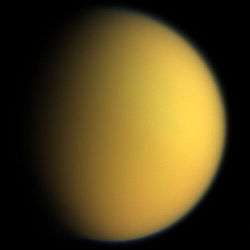Erebor Mons
Erebor Mons is a mountain on Titan, the largest moon of the planet Saturn. It is located near Titan's equator, between 4-5° south and 35-36° west, centered on 4°58′S 36°14′W / 4.97°S 36.23°WCoordinates: 4°58′S 36°14′W / 4.97°S 36.23°W,[1] in the western part of Quivira region.[2] It is 40 km across, more than 1 km high and has lobate flow features to its north and east. It is probably a cryovolcano.[3] Erebor Mons is situated about 470 km to the north-northeast of a larger cryovolcanic construct, Doom Mons.[3]
Erebor Mons is one of the highest known mountains of Titan, but it is not readily discernible on radar or infrared images. It was discovered only when stereoscopic radar data allowed construction of an elevation map. It was imaged by Cassini radar 22 February and 10 April 2007.[3]
Erebor Mons is named after Erebor, the "Lonely Mountain" that appears in J. R. R. Tolkien's fictional world of Middle-earth, most prominently in The Hobbit.[1] The name follows a convention that Titanean mountains are named after mountains in Tolkien's work.[4] The name was formally announced on November 13, 2012.[5]
References
- 1 2 "Erebor Mons". Gazetteer of Planetary Nomenclature. International Astronomical Union (IAU) Working Group for Planetary System Nomenclature (WGPSN). 2012-11-13. Retrieved 2014-06-07.
- ↑ United States Geological Survey. "Titan with VIMS background and RADAR strips". Accessed 14 Nov, 2012.
- 1 2 3 Lopes, R. M. C.; Kirk, R. L.; Mitchell, K. L.; Legall, A.; Barnes, J. W.; Hayes, A.; Kargel, J.; Wye, L.; Radebaugh, J.; Stofan, E. R.; Janssen, M. A.; Neish, C. D.; Wall, S. D.; Wood, C. A.; Lunine, J. I.; Malaska, M. J. (2013). "Cryovolcanism on Titan: New results from Cassini RADAR and VIMS" (PDF). Journal of Geophysical Research: Planets. 118 (3): 416–435. Bibcode:2013JGRE..118..416L. doi:10.1002/jgre.20062.
- ↑ International Astronomical Union. "Categories for Naming Features on Planets and Satellites". Gazetteer of Planetary Nomenclature. Accessed Nov 14, 2012.
- ↑ Jennifer Blue, "Eight New Names for Titan Surface Features". USGS Astrologeology Science Center. Nov 13, 2012.
External links
- Map of Titan with names of geologic features (PDF, 1,4 Mb)
- Jason Perry (2013-06-11). "Titan RADAR SAR Swaths". The University of Arizona. Planetary Image Research Laboratory. Retrieved 2014-05-18.
.png)
